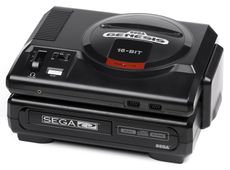Difference between revisions of "Sega CD"
(Created page with "{{Template:Infobox console |Manufacturer = SEGA |Generation = Fourth generation |Release date = December 12, 1991 (JP)<br/> October 15, 1992 (NA)<br/> April 19, 1993 (EU) ...") |
m |
||
| Line 5: | Line 5: | ||
October 15, 1992 (NA)<br/> | October 15, 1992 (NA)<br/> | ||
April 19, 1993 (EU) | April 19, 1993 (EU) | ||
| − | |Media type = [[CD | + | |Media type = CD-ROM & [[CD+G]]|image = [[Image:Sega-CD-Model1.jpg|230px]] |
| + | |caption = Model 1 Sega CD & Model 1 Sega Genesis}}The Sega Mega-CD (メガCD Mega Shī Dī) (released as the Sega CD in North America) is an add-on device for the [[Sega Mega Drive/Genesis]] video game console, designed and produced by Sega. The device adds a CD-ROM drive to the console, allowing the user to play CD-based games and providing additional hardware functionality. It can also play audio CDs and CD+G discs. | ||
The first version of the Mega-CD sits underneath the Mega Drive console and loads CDs via a motorized tray. A second version places a top-loading CD-ROM drive to the right of the console and is intended primarily for use with the redesigned Mega Drive II. Both versions of the Mega-CD are compatible with the initial two versions of the Mega Drive console, but not with the Genesis 3. | The first version of the Mega-CD sits underneath the Mega Drive console and loads CDs via a motorized tray. A second version places a top-loading CD-ROM drive to the right of the console and is intended primarily for use with the redesigned Mega Drive II. Both versions of the Mega-CD are compatible with the initial two versions of the Mega Drive console, but not with the Genesis 3. | ||
| + | ==Technical specifications== | ||
| + | |||
| + | |||
| + | |||
| + | ===Models=== | ||
| + | |||
| + | *Mega-CD I (Sega CD I in North America) | ||
| + | *Mega-CD II (Sega CD II in North America). Designed for the Mega Drive 2/2nd model Genesis (also compatible with the Mega Drive/1st model Genesis and included a special add-on for this purpose) and to reduce manufacturing costs. | ||
| + | *Victor Wondermega RG M2 | ||
| + | *JVC Wondermega RG M1 (released on April 1, 1992 only in Japan): combination Mega Drive/Mega-CD player with enhanced sound, video and karaoke capabilities and a mechanized CD tray lid. Also included MIDI functionality. Sega themselves released on April 24, 1992 a variation of this unit with slight cosmetic changes, but functionality remains identical, branded as Sega Wondermega) | ||
| + | *JVC Wondermega Model RG M2 (JAPAN-ONLY: a second model with a different case design and wireless controller functionality built in. The mechanized CD tray was omitted in favor of a more conventional spring-loaded tray design. Otherwise, functionally identical to the Wondermega I. This model was stripped down released in the US as the X'Eye.) | ||
| + | *Sega Multi-Mega (called Sega CDX in North America). A portable CD player that plays both Mega Drive and Mega-CD games, as well as audio CDs, and CD-G discs. Resembling a slightly longer version of the typical portable CD player of the day. | ||
| + | *Pioneer LaserActive Sega Mega-CD module, an add-on device available for the LaserActive system | ||
[[Category:Add-on]] | [[Category:Add-on]] | ||
[[Category:Sega Genesis]] | [[Category:Sega Genesis]] | ||
Revision as of 12:03, 31 May 2013
[[File: |230px]] |230px]]
| |
| Manufacturer | SEGA |
|---|---|
| Generation | Fourth generation |
| Release date | December 12, 1991 (JP) October 15, 1992 (NA) |
| Media type | CD-ROM & CD+G |
The Sega Mega-CD (メガCD Mega Shī Dī) (released as the Sega CD in North America) is an add-on device for the Sega Mega Drive/Genesis video game console, designed and produced by Sega. The device adds a CD-ROM drive to the console, allowing the user to play CD-based games and providing additional hardware functionality. It can also play audio CDs and CD+G discs.
The first version of the Mega-CD sits underneath the Mega Drive console and loads CDs via a motorized tray. A second version places a top-loading CD-ROM drive to the right of the console and is intended primarily for use with the redesigned Mega Drive II. Both versions of the Mega-CD are compatible with the initial two versions of the Mega Drive console, but not with the Genesis 3.
Technical specifications
Models
- Mega-CD I (Sega CD I in North America)
- Mega-CD II (Sega CD II in North America). Designed for the Mega Drive 2/2nd model Genesis (also compatible with the Mega Drive/1st model Genesis and included a special add-on for this purpose) and to reduce manufacturing costs.
- Victor Wondermega RG M2
- JVC Wondermega RG M1 (released on April 1, 1992 only in Japan): combination Mega Drive/Mega-CD player with enhanced sound, video and karaoke capabilities and a mechanized CD tray lid. Also included MIDI functionality. Sega themselves released on April 24, 1992 a variation of this unit with slight cosmetic changes, but functionality remains identical, branded as Sega Wondermega)
- JVC Wondermega Model RG M2 (JAPAN-ONLY: a second model with a different case design and wireless controller functionality built in. The mechanized CD tray was omitted in favor of a more conventional spring-loaded tray design. Otherwise, functionally identical to the Wondermega I. This model was stripped down released in the US as the X'Eye.)
- Sega Multi-Mega (called Sega CDX in North America). A portable CD player that plays both Mega Drive and Mega-CD games, as well as audio CDs, and CD-G discs. Resembling a slightly longer version of the typical portable CD player of the day.
- Pioneer LaserActive Sega Mega-CD module, an add-on device available for the LaserActive system